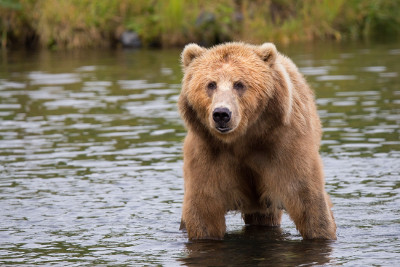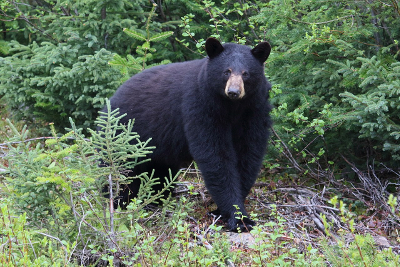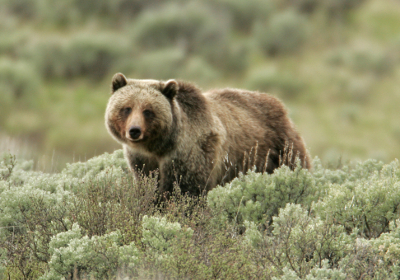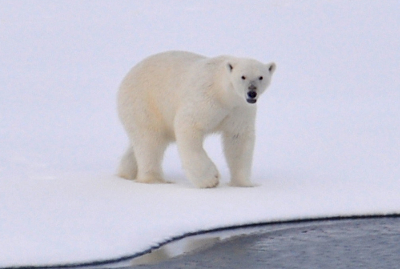Bear Attacks

Bear attacks is a subject that sounds sensational to some and seems inevitable to others. The fact of the matter is that bear attacks, though uncommon, do happen. Misconceptions about bear behavior and safe travel in bear country are common and deserve to be addressed so that those of us who live and recreate in bear country can make the most of our time. Irrational fears and unfounded confidence can both lead to unecessary conflict.
It is oft-quoted that you are more likely to be struck by lightning then you are to be attacked by a bear. While this is true for the average American, a bit of nuance here is necessary. Most Americans don’t spend a great deal of time in bear country and have little cause for concern. Agonistic encounters with bears are relatively more common for certain demographics. A bow hunter in the Bob Marshall Wilderness or a backpacker in Wyoming’s Absaroka range, for example, would both be more likely to have to deal with a bear than an urban Seattleite. People get struck by lightning and attacked by bears every year. Danger shouldn’t be dismissed because it is uncommon or rare.
All that being said, bears shouldn’t keep you out of the woods. Bears can be a significant part of the wilderness experience and we should appreciate their presence. Remote places feel fuller and more engaging in the presence of bears and many would be loathe to see them go.
Types of Bears
To begin our discussion about bear attacks and safety we should look at the different types of bears we have here in North America, some aspects of their biology, and their identification. Understanding the biology and behavior of the different species is an important starting point for avoiding uncomfortable encounters.
We have three bears native to North America: American black bear, grizzly bear, and polar bear. We can make some broad generalizations about the three species, especially the black bear and grizzly bear. All three species are carnivores, but black bears and grizzlies are really more accurately labeled as omnivores, and consume large quantities of plant matter.
Bears rely primarily on their sense of smell but have excellent hearing, and their sight is much better than commonly believed. All three species hibernate, or enter a period of dormancy in the winter months. All members of the population hibernate in black and grizzly bears, but in polar bears typically only pregnant females hibernate, and other members of the population stay active throughout the winter. Cubs are born in the den, and emerge in spring with their mother. All three species are highly intelligent, and this expresses itself in their curious nature.
Although sharing many similarities, some of the subtle differences between these species lead to tangible differences in behavior. Evolutionary history and specific adaptations to the environments they inhabit both have important consequences in their relationship with humans. For the sake of simplicity we will focus predominately on the grizzly and black bear because these are the species that are most likely to be encountered and which have been studied most thoroughly.
American Black Bear

On average the smallest of our bears, the American black bear is also the most common. Once found from coast to coast throughout most of North America, black bears now occupy about 62% of their historic range. Black bear populations are thriving in most western states as well as much of Appalachia and New England. Washington State alone has between 25,000 and 30,000 black bears. This is the bear that most folks in the United States will be most likely to encounter.
Black bears in Washington State are typically found in heavy timber and thick brush, and usually aren’t seen far from tree cover. Wetlands, forest clearings, riparian corridors, and overgrown roads are all heavily used and places you are relatively likely to encounter a black bear. Well adapted for a forested environment, black bears are adept at tree climbing and often use this ability to elude danger. Having evolved in a sylvan context, black bears typically rely on escape rather than aggression as their primary defensive strategy.
Black bears are the least carnivorous of our bears and feed on an abundance of plant matter, including grasses and sedgs, skunk cabbage, cambium, and berries. Social insects, such as wasps, actually comprise the bulk of animal matter consumed, but black bears will also take advantage of carrion, deer fawns, and occasionally make predatory attacks on larger animals when the opportunity arises. Black bears in Washington State will typically weigh between 75 and 300 pounds, but occasionally signigficantly more, depending on age, sex, food availability, and season.
Although shy, the black bear is also likely the most adaptable of the eight bears species on earth, as well as the most numerous. When pressed, black bears adapt to human presence relatively quickly, regardless of their retiring nature.
Grizzly Bear

Once a faltering symbol of American wilderness, the grizzly is now recovering or stable in some of its former haunts. Even so, grizzlies only inhabit a small percentage of their historic range in the lower 48 states, in several distinct populations. The Yellowstone and Northern Continental Divide populations in Wyoming and Montana harbor the greatest concentration of these bears south of the Canadian border.
In Washington State the Selkirk population likely contains somewhere around 70 or 80 bears, and the North Cascades population less than 10. Most people in Washington are unlikely to encounter a grizzly bear going about their daily lives, but some areas which grizzlies inhabit in greater numbers are popular travel destinations.
These inspirational bears go by a number of monikers throughout their range, but it’s helpful to remember that, regardless of whether they be called grizzlies, brown bears, Kodiak bears, or Coastal Alaskan brown bears, they are all one species: Ursus arctos.
Unlike black bears, grizzlies evolved in the open expanses of the pleistecene north. Occupying more exposed habitats and bearing longer claws more suitable for digging than for climbing, these bears have adopted a more aggressive disposition than their smaller cousins. Unable to effectively flee from danger grizzlies will often choose to confront it. This trait leads to the higher relative number of human conflicts with grizzlies compared to black bears.
The grizzly bear is relatively more carnivorous than the black bear. Although plant matter still makes up a large percentage of their diet, grizzlies also rely heavily on carrion, salmon, elk calves, small mammals, and even congregations of moths to supplement their diet. Grizzlies in Yellowstone can have a diet that is as much as 95% carnivorous.
The size of these bears is largely dependent on their diet, but they are typically larger than black bears regardless. An adult male in Yellowstone might weigh 400 to 600 pounds, but the same animal in coastal Alaska could be 800 to 1000. Bears with access to higher protein diets are able to attain larger size, hence the the relatively massive bears in coastal Alaska where salmon runs are prolific.
Polar Bear

The unmistakable emblem of the arctic, polar bears are on average our largest, and also least common Ursid. Tied exclusively to the arctic ocean and dependent on sea-ice, the polar bear is unlikely to be seen by most people in North America.
Reductions in arctic sea-ice threaten to impact polar bear populations over the coming century, and have made them a rallying point in environmentalism as it pertains to global climate change.
The polar bear is the largest and also most carnivorous of our bear species. Adapted to the arctic environment and life on the ice, polar bears diets are almost entirley comprised of seals and other marine mammals.
Types of Bear Attacks
When discussing bear attacks it’s important to realize that not all attacks happen for the same reasons. Without this knowledge we may behave inappropriately in the event of an agonistic encounter with a bear. Bear attacks on humans will generally fall into one of two broad categories: defensive-aggressive and predatory. The most important distinction to draw is between defensive-aggressive and predatory attacks, as the necessary reactions to these will likely be quite different.
Defensive-Aggressive Bear Attacks
Defensive-aggressive bear attacks are those attacks which occur upon suddenly encountering a bear. The bear views the human as a threat and attacks in an effort to mitigate the perceived threat. Defensive-aggressive attacks often arise as a result of surprising a bear at close quarters, especially females with cubs or near a defended food source such as a carcass.
Defensive-aggressive attacks tend to be short lived, generally not lasting more than several minutes. In these events bears are often encountered in such proximity that time for reaction is scant. Many people involved in these incidents were not aware of the bear until moments before physical contact. Bears will typically break off the attack after they feel the perceived threat has been neutralized.
Because the goal of the bear in these attacks is to eliminate an immediate threat, it is important to appear as non-threatening as possible. This is the classic ‘play dead’ situation. You want to protect your face, neck, and vitals. Attempt to lay face down on the ground and protect your neck and head with your arms and hands. Spread your legs slightly to make yourself more stationary, and if the bear does manage to flip you, attempt to roll with it to get back on your stomach. If you are wearing a backpack, leave it on as it may provide additional protection.
The majority of serious defensive-aggressive bear attacks are perpetrated by grizzlies, especially females with cubs. While black bears will occasionally attack defensively, it’s relatively less common and to this date, no recorded human death has ever resulted from a sudden encounter with a black bear. Extra caution is warranted whenever traveling in grizzly country.
Predatory Bear Attacks
In this case the bear, in it’s capacity as a predator, is attempting to prey upon a human as a potential food source. Predatory bear attacks tend to occur more often in remote places where bears have little experience with humans. Although much less common, when they do occur predatory attacks are potentially more dangerous due to the bear's determination and intent. Again, it is important to be able to distinguish defensive-aggressive behavior versus predatory behavior because the appropriate responses are quite different.
In the case of a predatory attack, bears will typically either attack at night, or approach their intended victim slowly during the day. This is sometimes preceded by the bear stalking the person for an indeterminate time. They will typically be focus locked, staring at the victim, and attempting to circle around behind them. This is often followed by charges, where the bear attempts to knock the person off their feet.
In this situation, playing dead is a categorically poor choice. Because the bear is intending to kill and consume the person involved in such an incident, playing dead will only expedite the process. The goal here is instead to appear as threatening as possible. In the case of a predatory attack, all reasonable attempt should be made to fight the bear off. Ideally this will start well before the bear ever makes physical contact. Throwing sticks and rocks, shouting, and making yourself appear physically dominant are good initial deterrents. In the unfortunate event that a bear decides to follow through with a predatory attack, fight back with anything you have.
Although grizzlies are genreally more dangerous and responsible for a greater number of serious attacks, black bears seem to be more likely to make predatory attempts on humans. The vast majority of serious black bear attacks seem to have had predatory motivations. Both species will, however, occasionally attempt to prey on humans. Polar bear attacks, although incredibly rare due to the remote nature of their habitat and lack of human interaction, seem to be universally driven by predatory intentions.
Be More Prepared For Your Next Outdoor Adventure!

Don't leave home without knowing these six essential survival skills. Our free survival mini guide reveals the strategies of:
- Shelter & fire to prevent the number one cause of death
- Obtaining clean water to avoid life-threatening dehydration
- Common wild survival foods and other critical skills!

The Bottom Line - How to Respond
It is critical to remember that bear behavior is incredibly complex and difficult to predict. The outcome of an interaction with a bear rests as much on circumstance as it does on the predilections and disposition of the individual bear. It is impossible to give advice that will work in 100% of bear encounters, because each will be unique. Doing the right thing can still precede injury or death. However, some generalizations can be made which will increase the odds of surviving an agonistic bear encounter.
If a bear charges you, never run; always hold your ground. Many charges are bluffs that will be broken off at the last moment, but running can trigger the bear to follow through with an attack that it otherwise might not have. Running can also potentially trigger a predatory response in a bear acting defensively.
If you encounter a bear appearing uncomfortable or defensive at your presence attempt to back away slowly, while speaking softly and reassuringly, and avoiding eye contact. The goal is to avoid triggering a defensive-aggressive attack. Always yield to bears and give them plenty of room to move off.
Defensive-aggressive attacks should be responded to by attempting to appear non-threatening, and playing dead. Sudden attacks by grizzly bears during the day are typically defensive-aggressive. These attacks generally break off relatively quickly, but can escalate if the victim resists.
Predatory attacks should be fought with all the ferocity you can muster. Your goal is to convince the bear that you are not worth the trouble of a predatory attempt. Persistent attacks by black bears during the day, or nighttime attacks are generally predatory. Defensive-aggressive attacks can sometimes transition to predatory in nature, and should be fought if this seems to be the case.
If there is time, escaping to safe cover is always ideal. Climbing trees is a viable option to escape grizzly attacks, if there is a tree that can be climbed quickly within a reasonable distance. Remember black bears are excellent climbers.
Avoiding Conflict
The best way to not die in a bear attack is to never be attacked by a bear. There are a few simple measures that can be taken to drastically reduce the odds of being attacked by a bear.
First and foremost, travel in groups and make noise while you travel, especially in grizzly country. There has never been a fatal bear attack on a group of four or more. This is dependent of course on the group sticking together; there have been several instances of bears mauling groups piecemeal as they encounter it one at a time. Casual conversation among a group of people is probably enough to a alert a bear to human presence, but in noisy conditions such as those near rivers or in heavy rain, or when traveling alone, shouting, singing, or clapping is advisable.
When traveling in the back-country, food should never be stored inside the tent overnight. Most national parks and wilderness areas have strict food storage policies that should be reviewed before any outing. A good general rule is that food should either be hung or stored in a bear proof container 100 yards from camp if possible.
One of the best defenses agaisnt bear attacks available to us now is pepper spray. Lightweight, and proven to be more effective than firearms in deterring bear attacks, there is no reason to not carry this potentially lifesaving resource. It is important to rememeber though that bear spray is useless in your pack. Most bear attacks happen much too quickly to retrieve something deeply stashed in a zippered pocket. Spray should be worn on the belt or chest strap where it is readily available and quickly deployed. Make sure you read the instructions and understand its use before you go out. Bear spray is available in most outdoor supply stores and national park offices.
It appears that although bears will occasionally attack people sleeping in tents, the tent does create some sort of psychological boundary that decreases risk of attack. Sleeping in a tent or shelter is generally safer than sleeping out.
Special care should be taken by hunters recovering kills in grizzly country. Bears will often claim hunter-killed animals surprisingly quickly and defened them as they will any other food resource. Bears can be incredibly aggressive around carcasses, and several deaths have resulted from bear attacks on hunters at kill sites. Kills should be approached cautiously from an upwind direction, if possible, and an excess of noise should be made to alert the bear to human presence and give it an opportunity to move off. If a bear claims your kill, cede ownership to the bear and contact your local game management agency.
Habituation
When we consider risk in our lives, we need to look at how that risk is multiplied over time. We also need to consider how our actions can effect others in the future. To reduce the risk of bear attacks we need to work together to create a culture of back-country use which discourages uncomfortable interactions with bears.
Some of the most dangerous bears are those, especially grizzlies, which have become habituated to human presence and come to rely on improperly stored food or garbage as a source of nutritional income. One night of improperly storing food might not lead to a dangerous situation, but over time bears may come to frequent an area where food is consistently available to them and associate human activity with food. These bears may come in close to people and tents in search of food, but react aggressively when confronted with a human. It is critically important that back-country users be able to rely on the people using an area before them to store food and clean up properly, so that when they arrive they won’t encounter a habituated bear searching for food.
Food storage practices have improved dramatically over the last few decades, but problems can still arise, especially in heavily used, but un-monitored, back-country or dispersed camping areas. When camping in grizzly country, be wary of camps with garbage left behind and always follow proper food storage protocol.
In Summary
Bears are powerful, resourceful, and intelligent creatures. Although potentially dangerous, bears contribute to, rather than detract from the wilderness experience. And they are not alone in their potential for risk. Many of the things which draw us to the wilderness are inherently dangerous, and this danger is part of their attraction. With a modicum of knowledge the risk of bear attacks can be greatly reduced, and these animals experienced without unwarranted fear. The risk however, is never entirely gone. Flippant behavior in bear country has led to unnecessary deaths, just as it has on mountains and in storms.
This is, by necessity a cursory overview. I recommend those who spend a great deal of time in bear country seek out further resources to understand bear behavior and the circumstances which lead to attacks. "Bear Attacks: Their Causes and Avoidance" by Steven Herrero is a well-researched and exhaustive resource on this subject. The specific and up-to-date information that can be provided by park rangers in the areas we wish to visit is invaluable, and I recommend checking in with visitor centers or local ranger stations before heading into the back-country.
Some of the most powerful and memorable experiences available to us in wilderness are those that we share with wildlife, and few species capture the imagination like bears. Our stories involving them are often the most requested and enjoyable to relate, but these stories need not be tragedies. Knowledge and levelheadedness can prevent most unnecessary conflicts and ensure our time in the outdoors is well spent and safe.
By the way, when you're out tracking or looking for wild animals, it's important to know how to stay safe in the outdoors, especially if you were to get lost. Right now you can get a free copy of our mini survival guide here, where you'll discover six key strategies for outdoor emergencies, plus often-overlooked survival tips.
Additional Resources:
Wildlife Tracking Courses at Alderleaf

About the Author: Jedidiah Forsyth is an experienced outdoor educator and wildlife tracker. He is a guest instructor at Alderleaf Wilderness College. Learn more about Jedidiah Forsyth.
Return from Bear Attacks back to Wildlife Tracking Articles
Is The Essential Wilderness Survival Skills Course Right for You? Take the "Online Survival Training Readiness" Quiz
See for yourself if this eye-opening course is a good fit for you. It takes just a few minutes! Get your Survival Training Readiness Score Now!

Grow Your Outdoor Skills! Get monthly updates on new wilderness skills, upcoming courses, and special opportunities. Join the free Alderleaf eNews and as a welcome gift you'll get a copy of our Mini Survival Guide.

 The Six Keys to Survival: Get a free copy of our survival mini-guide and monthly tips!
The Six Keys to Survival: Get a free copy of our survival mini-guide and monthly tips!
Learn more